LisbonLisboaPortugal.com
The best independent guide to Lisbon
LisbonLisboaPortugal.com
The best independent guide to Lisbon
Miradouro da Graça viewpoint, Lisbon – a guide for 2025
The Miradouro da Graça is one of the most famous and popular viewpoints of Lisbon, offering the classic rooftop panorama of the city.
The viewpoint lies within the Graça neighbourhood, on the southern side of the Santo André hill. From this vantage point, there are stunning views over the historic centre of Lisbon and - on a clear day - all the way out to the Tejo estuary.
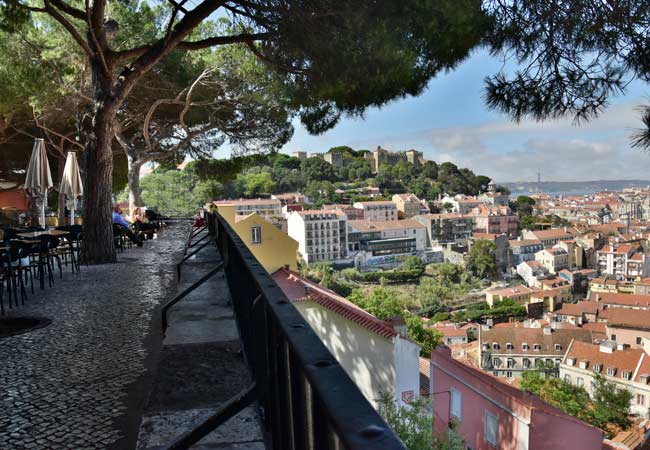
Miradouro da Graça provides one of the best views of Lisbon Castle
Graça viewpoint is a wonderful location during the day, but transforms into a truly magical setting in the evening as the sun descends behind the hills to the west, and the lights of Lisbon come on.
Being a popular tourist location, the Miradouro da Graça always has a vibrant atmosphere. Musicians and singers regularly perform here, and the Esplanada da Graça, the café at the viewpoint, is buzzing all day long.
The Miradouro da Graça is as far as many tourists venture within the Graça neighbourhood, but this is a shame as there are many interesting sights close by. Behind the viewpoint is the sprawling Convento da Graça, with its beautiful tile paintings and impressive baroque church. Close by is the Villa Sousa, a traditional 19th-century labour house, and below the viewpoint lies the peaceful Jardim da Cerca Park.
This article will provide a guide to the Miradouro da Graça and the sights of the surrounding region.
Insight: The Miradouro da Graça is located at GPS: 38.716, -9.131 (Link to Google Maps)
Related articles: The Graça neighbourhood - The best viewpoints of Lisbon
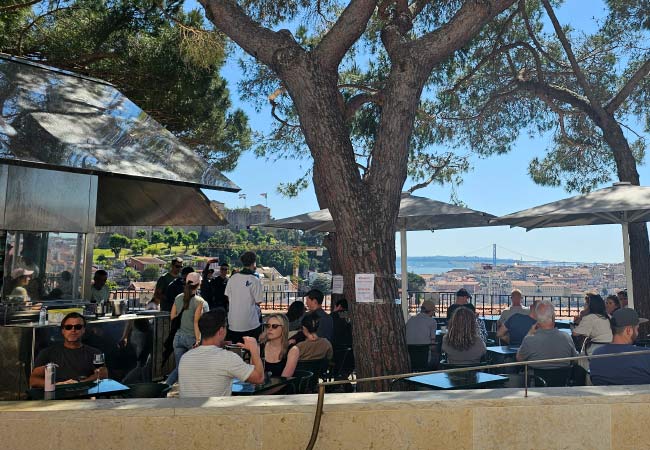
The Miradouro da Graça is a popular hangout for both tourists and locals
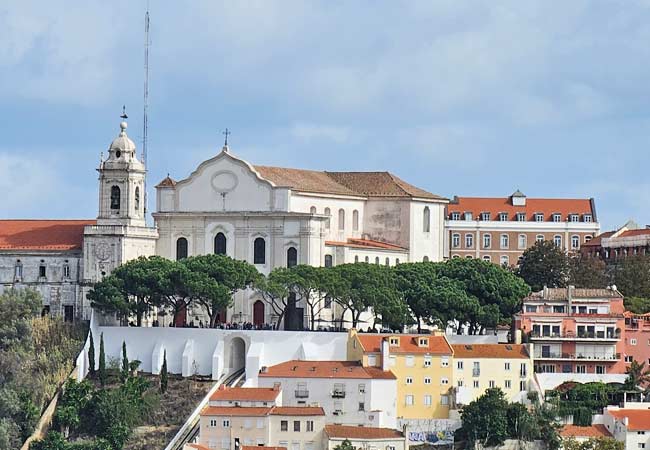
The Miradouro da Graça, as seen from Bairro Alto
What can be seen from the Miradouro da Graça viewpoint?
The Miradouro da Graça provides a 160-degree viewpoint over central and western Lisbon.
Looking southwest from the viewpoint, you can see the São Jorge castle, the Mouraria neighbourhood and Martim Moniz plaza. Further out are the ruins of the Carmo church, the Tejo estuary and the Ponte 25 de Abril bridge (4.7km away).
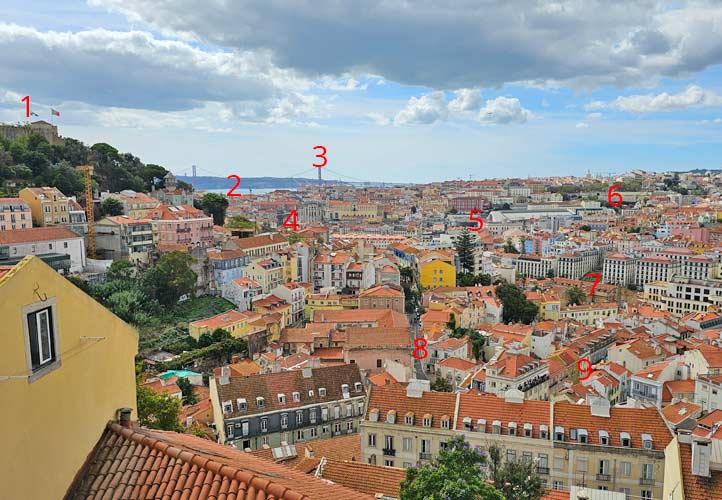
Sights looking southwest: 1) Castelo de São Jorge 2) Tejo estuary 3) Ponte 25 de Abril bridge 4) Igreja do Carmo 5) Rossio station 6) São Pedro de Alcântara viewpoint 7) Martim Moniz plaza 8) Rua Marquês de Lima 9) Rua dos Cavaleiros
The northwestern view is over the closely packed rooftops of the Intendente and Mouraria neighbourhoods. On a clear day, it is possible to see Monsanto Forest (4.8km) and the Amoreiras towers (2.7km).
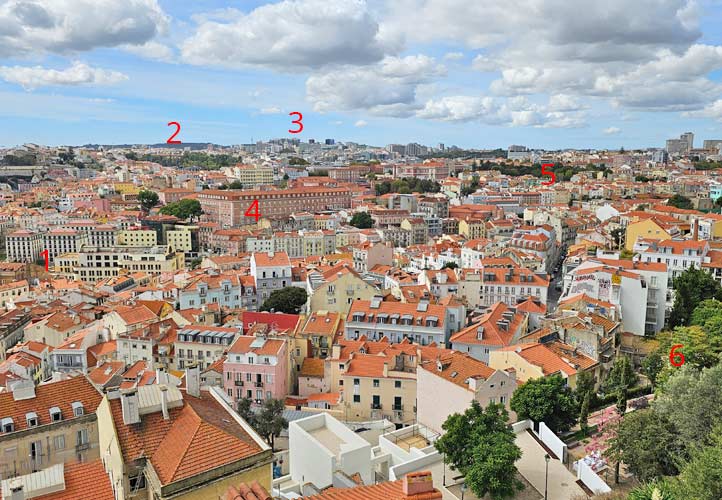
Sights looking west: 1) Martim Moniz 2) Monsanto forest 3) Amoreiras Towers 4) São José Hospital 5) Campo dos Mártires Park 6) Jardim da Cerca park
Below is an interactive image of the Miradouro da Graça viewpoint:
Miradouro Sophia de Mello Breyner Andresen
The Miradouro da Graça (Graça viewpoint) is the common name for the viewpoint, but its official title is the Miradouro Sophia de Mello Breyner Andresen (Sophia de Mello Breyner Andresen viewpoint), taking its name from a famous 20th-century Portuguese poet. Sophia Andresen was a celebrated writer who is best known by the Portuguese for her fairy tales 'The Girl from the Sea', 'The Fairy Oriana' and 'The Bronze Boy', as well as for creating the official translation of Shakespeare into Portuguese.
The Graça viewpoint was one of her favourite locations for inspiration, and it was renamed in her honour when she died in 2004.
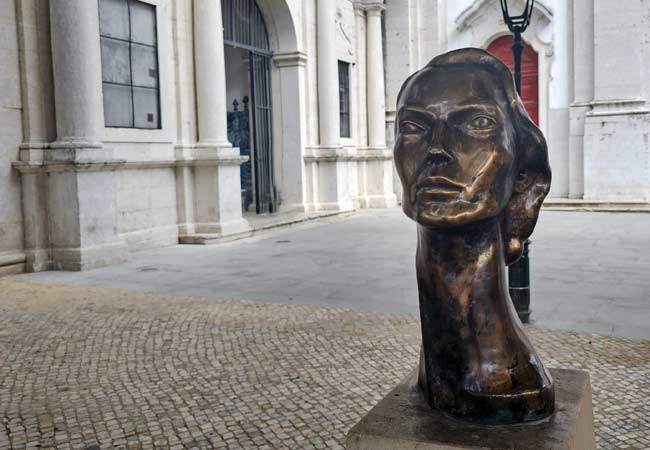
A bust of Sophia de Mello Breyner Andresen is found near the entrance to the Convento da Graça
Travel to the Miradouro da Graça
The Miradouro da Graça lies on the boundary of the Alfama and Graça districts, and sits above the Mouraria neighbourhood.
Most visitors walk to the viewpoint from the castle and Alfama district along the steeply-inclined Calçada da Graça.
There is an ongoing project to build a funicular (to be called the Elevador da Graça) that will link the Rua dos Lagares to the Miradouro da Graça.
The best option to travel up to Graça is to ride the number 28 tram, which departs from Martim Moniz (GPS 38.7153, -9.13602) or the Rua da Conceição (GPS: 38.71006, -9.1352) and then exit the tram at the Largo da Graça (GPS 38.7172, -9.12969). From the Largo da Graça it is a flat walk to the Miradouro da Graça.
Insight: After visiting the Miradouro da Graça, don't rush down the hill back into Alfama or Baixa, as there is a lot to see within the Graça neighbourhood. Graça is one of the most authentically Portuguese neighbourhoods of central Lisbon and contains many distinctive murals, including ‘Peace Guard’ and ‘Fado em Tons’. The district also contains one of the finest religious buildings of Lisbon, the Mosteiro de São Vicente de Fora.
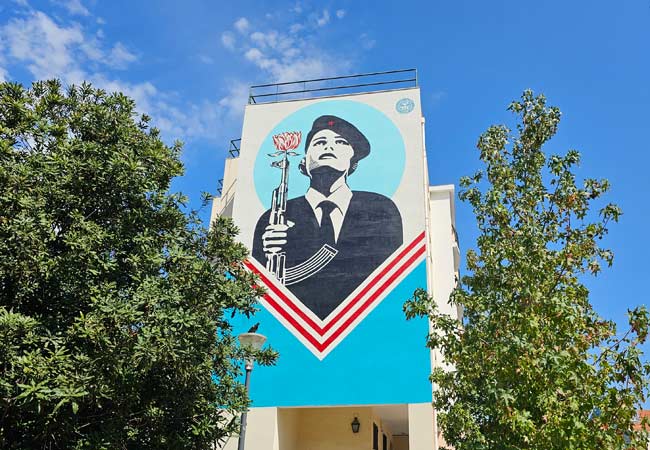
The ‘Peace Guard’ mural commemorates the 1974 revolution
Alternative viewpoints to the Miradouro da Graça
The Graça district has two other excellent viewpoints, the Miradouro da Senhora do Monte and the Miradouro da Jardim da Cerca.
These are both within walking distance of the Miradouro da Graça, and each could be considered better in their own unique way.
The Miradouro da Senhora do Monte lies at the highest point of central Lisbon and offers a better view than the Miradouro da Graça. The downside is that it is much smaller and gets extremely busy, with tourists being dropped off by the endless flow of tuk-tuk tours. Also, there is no permanent kiosk/café/bar at the Miradouro da Senhora do Monte, and it does not have the same pleasant atmosphere as the Miradouro da Graça.
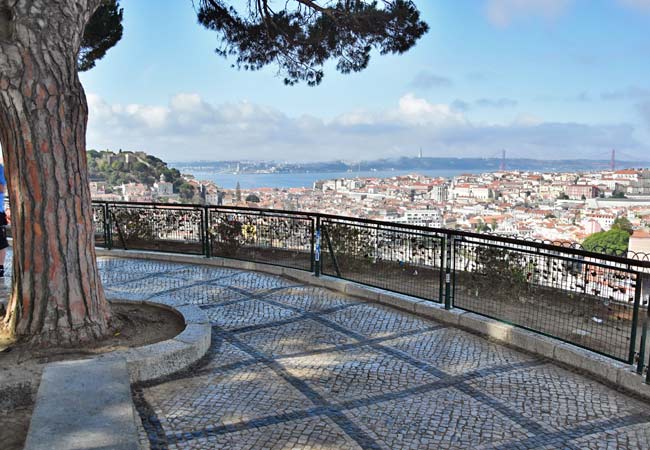
The Miradouro da Jardim da Cerca offers a peaceful ambience, as it is almost unknown to foreign tourists. It is especially romantic at sunset, when the other viewpoints are overly busy.
The only downside is that the Miradouro da Jardim da Cerca is not as high up the hill as Miradouro da Graça, so the views are not quite as spectacular.
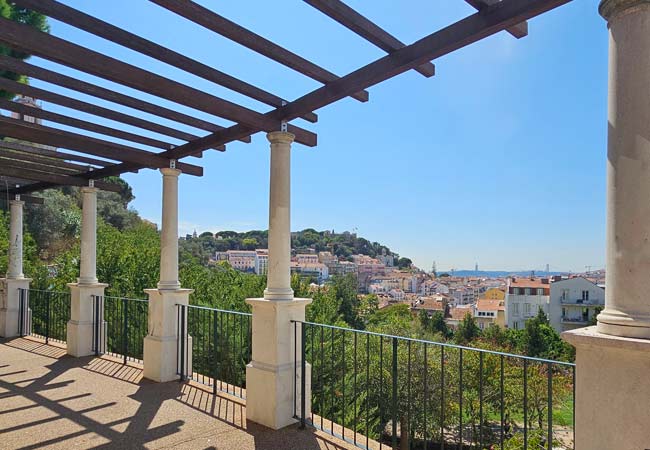
The Miradouro da Jardim da Cerca
Sights near the Miradouro da Graça
Convento da Graça
Sitting behind the Miradouro da Graça is the Convento da Graça (Graça Covent) and its attached church, the Igreja da Graça.
This expansive religious complex was one of the first convents established in Lisbon, under the order of King Afonso III in 1291. Almost nothing of this mighty medieval convent remains due to extensive remodelling in the 16th century, with the building then suffering major damage during the 1755 earthquake. After the 1834 dissolution of religious orders in Portugal, the covenant was transformed into a military complex and has only been open to the public since 2012.
The three areas of the Convento that can be entered for free are the chapel, chapter room and cloister, with paid admission (€5) to the terrace viewpoint next to the bell tower.
The convent and church that you can visit today are of the Baroque style that is commonly found throughout Lisbon, with this style having been extensively used during the reconstruction of the city after the earthquake.
The unique feature of the convent are the beautiful 18th-century tile paintings in the chapter room. These depict medieval Christian martyrs in violent battle scenes or moments before their deaths, and many faces of the martyrs’ attackers have been damaged and scratched out. Bizarrely, this semi-gruesome room was used a nursery during the early 20th century.
The church itself is very similar to many other churches in Lisbon, with a heavy and sombre atmosphere and painted walls to mimic marble effects. The key icon of the church is the 'Senhor dos Passos da Graça', a statue of Jesus carrying a cross, which is paraded through Graça on the second Sunday of Lent.
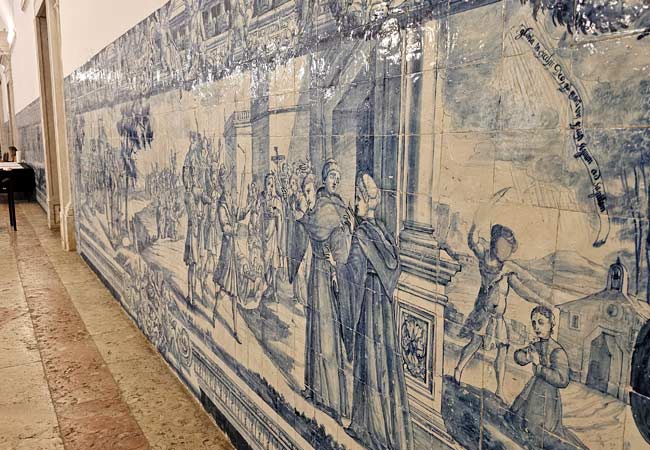
The Azulejos tile paintings of the chapter house
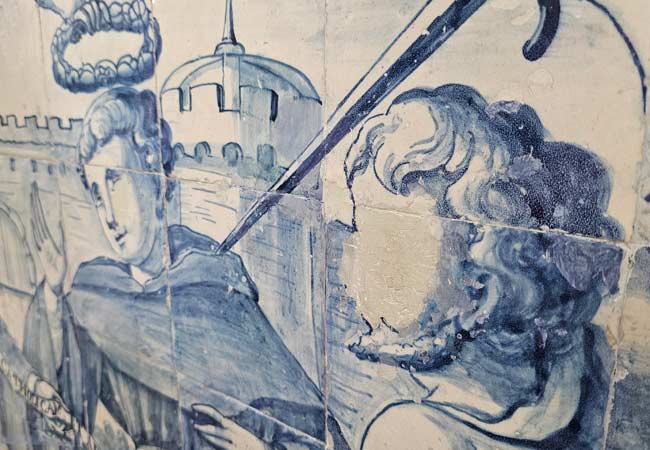
Many faces of the attackers were scratched out.
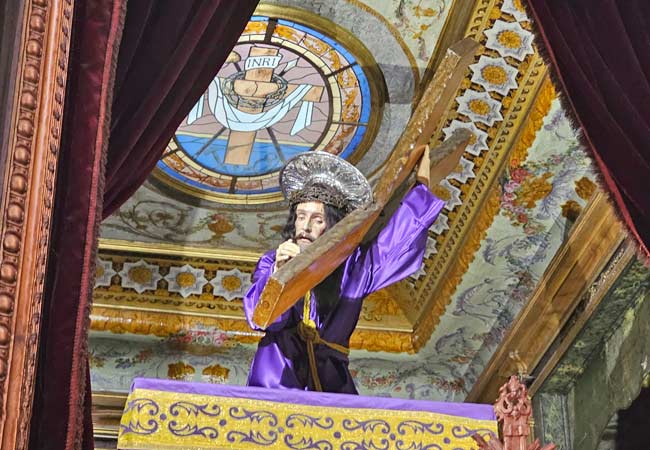
The 'Senhor dos Passos da Graça' statue
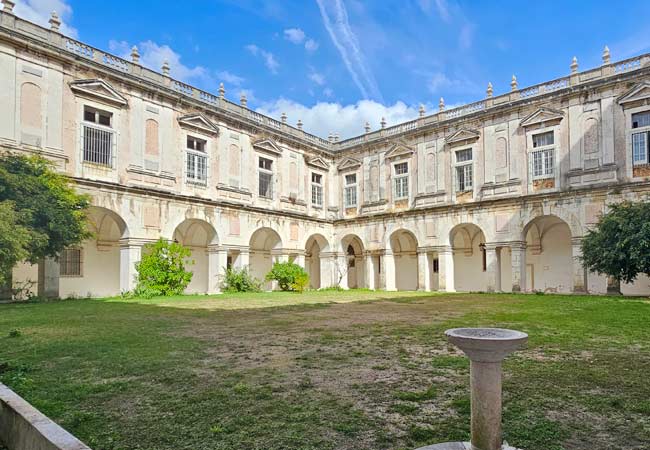
The simplistic styling of the central cloister in the Convento da Graça
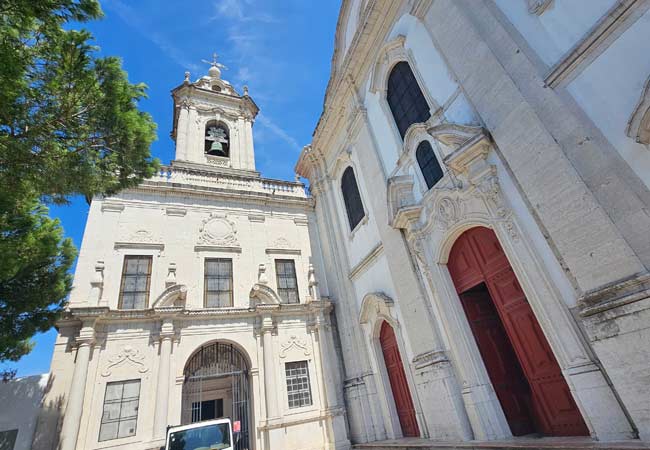
The entrance to the Graça church (right) and the convent (left)
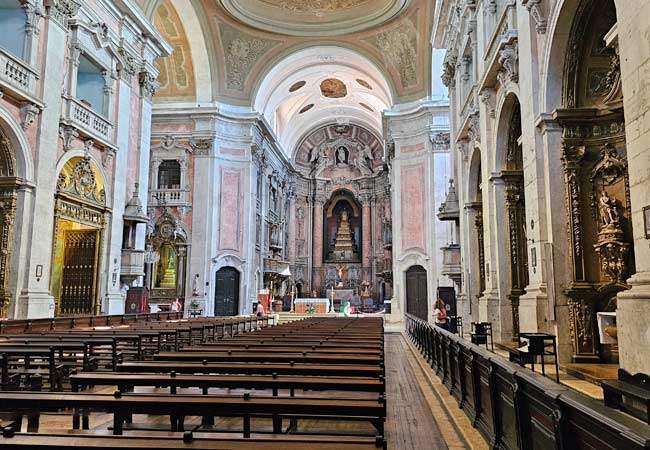
The Igreja da Graça is very similar to many of the churches rebuilt after the 1755 earthquake
Jardim Augusto Gil
The Jardim Augusto Gil is a small urban garden to the side of the Convento da Graça, which has an ornamental lake as its central feature.
The shaded benches of the garden offer a pleasant area to sit, especially if the Esplanada da Graça café is full. In the park is the distinctive ‘Mãe e Filho’ statue.
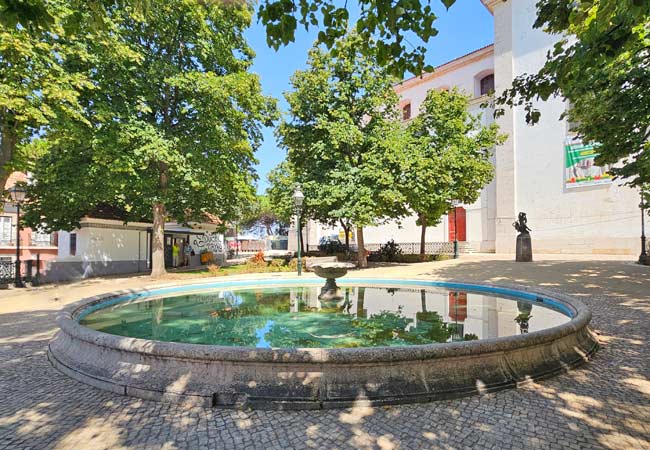
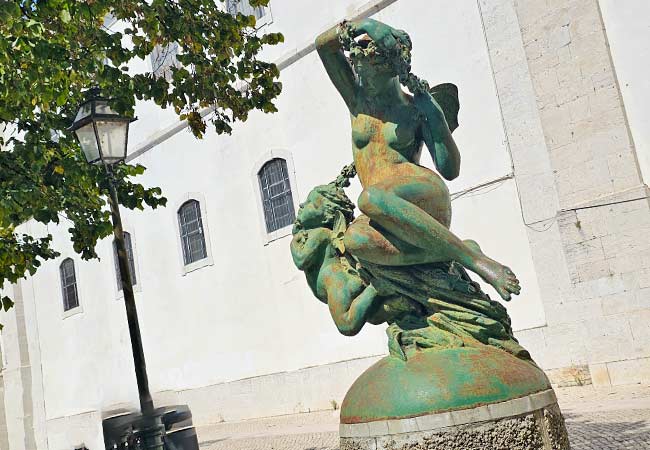
The Mother and Child (Mãe e Filho) statue
The Villa Sousa
Graça was traditionally a working-class neighbourhood that grew during the early 20th century with the industrialisation of Lisbon. The neighbourhood contained many labour-intensive factories, and the workers were housed in purpose-built residential buildings.
The Villa Sousa is the one of the best examples of a labour house in Graça, and follows the typical layout with a private courtyard at its centre. The exterior of the Villa Sousa is decorated with green tiles, and this front building was where the factory owner lived, while the workers lived to the rear.
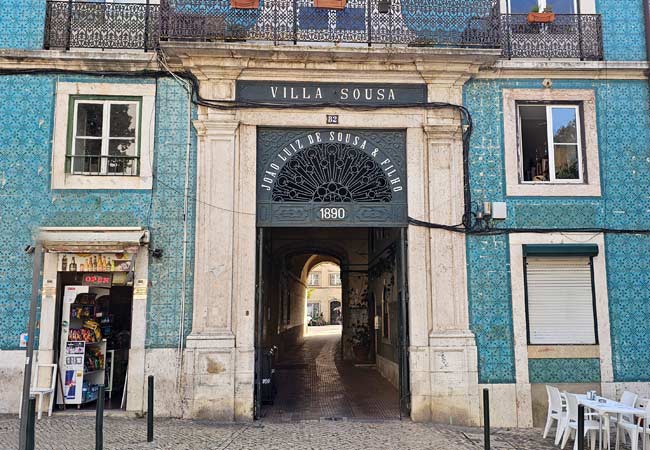
The entrance to the Villa Sousa, with the tunnel leading to the private central courtyard
Discover more of Lisbon with our most popular guides
If you've found our content valuable, we'd welcome your support.
The digital publishing landscape has evolved significantly. As a small independent publisher, we face growing challenges. Search engines increasingly favour paid content over organic results, while AI-generated content often reproduces original work without attribution.
To support our work, please consider bookmarking this page (press Ctrl + D) for quick access. If you find an article helpful, we'd be grateful if you'd share it with friends on social media.
For specific questions, please see our Reddit community at r/LisbonPortugalTravel.
Should you notice any outdated or incorrect information, please contact us at [email protected]
Thank you for helping us continue to provide valuable content in an increasingly challenging digital environment.
A complete list of all of our Lisbon articles
If you've found our content valuable, we'd welcome your support.
The digital publishing landscape has evolved significantly. As a small independent publisher, we face growing challenges. Search engines increasingly favour paid content over organic results, while AI-generated content often reproduces original work without attribution.
To support our work, please consider bookmarking this page (press Ctrl + D) for quick access. If you find an article helpful, we'd be grateful if you'd share it with friends on social media.
For specific questions, please see our Reddit community at r/LisbonPortugalTravel.
Should you notice any outdated or incorrect information, please contact us at [email protected]
Thank you for helping us continue to provide valuable content in an increasingly challenging digital environment.



































